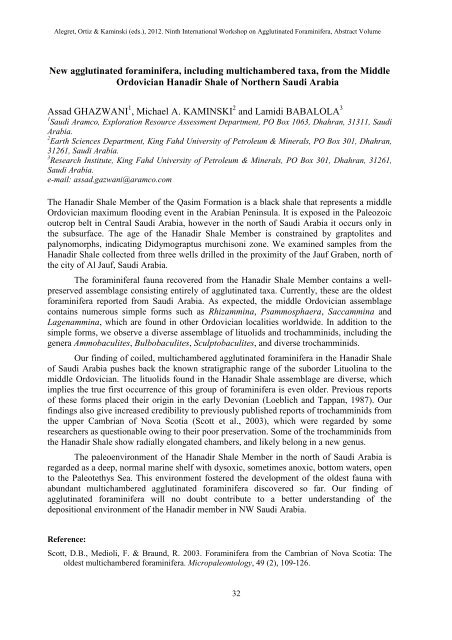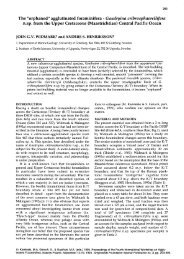Full Text | Download - Grzybowski Foundation - The ...
Full Text | Download - Grzybowski Foundation - The ...
Full Text | Download - Grzybowski Foundation - The ...
Create successful ePaper yourself
Turn your PDF publications into a flip-book with our unique Google optimized e-Paper software.
Alegret, Ortiz & Kaminski (eds.), 2012. Ninth International Workshop on Agglutinated Foraminifera, Abstract Volume<br />
New agglutinated foraminifera, including multichambered taxa, from the Middle<br />
Ordovician Hanadir Shale of Northern Saudi Arabia<br />
Assad GHAZWANI 1 , Michael A. KAMINSKI 2 and Lamidi BABALOLA 3<br />
1 Saudi Aramco, Exploration Resource Assessment Department, PO Box 1063, Dhahran, 31311, Saudi<br />
Arabia.<br />
2 Earth Sciences Department, King Fahd University of Petroleum & Minerals, PO Box 301, Dhahran,<br />
31261, Saudi Arabia.<br />
3 Research Institute, King Fahd University of Petroleum & Minerals, PO Box 301, Dhahran, 31261,<br />
Saudi Arabia.<br />
e-mail: assad.gazwani@aramco.com<br />
<strong>The</strong> Hanadir Shale Member of the Qasim Formation is a black shale that represents a middle<br />
Ordovician maximum flooding event in the Arabian Peninsula. It is exposed in the Paleozoic<br />
outcrop belt in Central Saudi Arabia, however in the north of Saudi Arabia it occurs only in<br />
the subsurface. <strong>The</strong> age of the Hanadir Shale Member is constrained by graptolites and<br />
palynomorphs, indicating Didymograptus murchisoni zone. We examined samples from the<br />
Hanadir Shale collected from three wells drilled in the proximity of the Jauf Graben, north of<br />
the city of Al Jauf, Saudi Arabia.<br />
<strong>The</strong> foraminiferal fauna recovered from the Hanadir Shale Member contains a wellpreserved<br />
assemblage consisting entirely of agglutinated taxa. Currently, these are the oldest<br />
foraminifera reported from Saudi Arabia. As expected, the middle Ordovician assemblage<br />
contains numerous simple forms such as Rhizammina, Psammosphaera, Saccammina and<br />
Lagenammina, which are found in other Ordovician localities worldwide. In addition to the<br />
simple forms, we observe a diverse assemblage of lituolids and trochamminids, including the<br />
genera Ammobaculites, Bulbobaculites, Sculptobaculites, and diverse trochamminids.<br />
Our finding of coiled, multichambered agglutinated foraminifera in the Hanadir Shale<br />
of Saudi Arabia pushes back the known stratigraphic range of the suborder Lituolina to the<br />
middle Ordovician. <strong>The</strong> lituolids found in the Hanadir Shale assemblage are diverse, which<br />
implies the true first occurrence of this group of foraminifera is even older. Previous reports<br />
of these forms placed their origin in the early Devonian (Loeblich and Tappan, 1987). Our<br />
findings also give increased credibility to previously published reports of trochamminids from<br />
the upper Cambrian of Nova Scotia (Scott et al., 2003), which were regarded by some<br />
researchers as questionable owing to their poor preservation. Some of the trochamminids from<br />
the Hanadir Shale show radially elongated chambers, and likely belong in a new genus.<br />
<strong>The</strong> paleoenvironment of the Hanadir Shale Member in the north of Saudi Arabia is<br />
regarded as a deep, normal marine shelf with dysoxic, sometimes anoxic, bottom waters, open<br />
to the Paleotethys Sea. This environment fostered the development of the oldest fauna with<br />
abundant multichambered agglutinated foraminifera discovered so far. Our finding of<br />
agglutinated foraminifera will no doubt contribute to a better understanding of the<br />
depositional environment of the Hanadir member in NW Saudi Arabia.<br />
Reference:<br />
Scott, D.B., Medioli, F. & Braund, R. 2003. Foraminifera from the Cambrian of Nova Scotia: <strong>The</strong><br />
oldest multichambered foraminifera. Micropaleontology, 49 (2), 109-126.<br />
32



